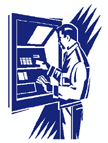 
|
|

How Are Everyday Technologies Kept Safe?
Fact sheet #6 looks at safety and security issues of
some everyday technologies.
Along with new technologies, new ways of committing crime have also turned
up. From electronic crime to fraudulent charities, technology has provided
new tools for criminals. Technology is also part of the solution, as companies,
banks, organizations, police services and governments share information
and take measures to combat such crime. Banks and internet service
providers (ISPs) have developed pass codes and encryption security
systems to protect their customers. Although some crimes and fraud schemes
are targeted directly at older adults, there are a few simple guidelines
you can follow that will greatly lessen your chances of being ‘stung'.
Of course, the first and best defence is to be cautious when conducting
any transaction that involves your money or your privacy.
Automated Banking Machine (ABM) Safety Tips

- Be aware of those around you, both in a line-up and at the machine.
- Be discreet when entering in your Personal Identification Number (PIN)
at a banking machine, or at a store retail machine.
- Shield the keypad with your body or hand.
- Do not write your PIN down or share it. If you must write it down,
keep it separate from your card.
- Be sure to remove your card and your cash from the ABM.
- If you need assistance, do not ask the person behind you. Go into
the bank and speak to an employee.
- Keep your ABM transaction slips and debit receipts to check against
your monthly bank statement or passbook.
Internet Safety Tips
- Delete any e-mail you receive from unknown companies or unknown senders
(e-mails also called spam). Or click on ‘Block sender' which
will delete incoming messages from e-mail addresses on your ‘Block
Sender List'.
- If you are shopping online, deal with reputable companies which clearly
provide contact information and security assurances.
- Ask an unknown company for references and check them out before purchasing
online.

- Look for a symbol on the top or bottom of your computer screen that
looks like an unbroken key or a closed padlock to show that you are
in a secure environment when you enter credit card information.
- If you visit ‘chat rooms' or online ‘discussion groups',
do not volunteer personal information such as your name, phone number
or address.
- If you visit the internet regularly, look into having what is called
‘firewall' software installed to protect your computer against
hackers or find out if your computer already has such security
measures in place.
- Check for virus e-mails sent with attachments by saving them to a
disk first and then running your antivirus program.
Telemarketing Fraud
Although there are many legitimate telemarketing firms, every 48 hours
another fraudulent company is identified. In 2000, more than 50 percent
of Canadian victims were over 60 years of age and more than 60 percent
of reported fraud victims were women. Legitimate telemarketing firms do
not use pressure tactics or ask for cash only and will send out written
material, giving ample time to make a decision.
PhoneBusters is a national call centre for reporting deceptive
telemarketing. It is operated by the Ontario Provincial Police since 1993
and is accessible from across the country in both official languages.
Besides educating the public, PhoneBusters collects and disseminates
victim evidence and statistics to law enforcement agencies. A new free
video called Stop Phone Fraud–IT'S A TRAP is now available.
Phone 1-888-495-8501 for your copy or to arrange a presentation
for your organization.
SeniorBusters is a group of volunteers working with PhoneBusters
to give information and telephone support to older adults who may have
experienced telephone fraud. To report a fraud or get information you
can reach PhoneBusters or SeniorBusters at 1-888-495-8501.
Or you can visit their web site at: www.phonebusters.com 
Beware of…
|
Consumer privacy has become a major concern for many Canadians
with the increased use of debit cards, telephone and internet banking,
point system award programs and other methods of information storage.
Protect your personal information - social insurance numbers, health
card numbers, account numbers, and marital status are all private
information!
|
| The best way to deal with fraud is to
prevent it. Be aware. Be prepared. Be alert! |
- being told you've won a contest you have not entered.
- being told you have to pay a ‘small fee' or shipping charge
to claim a prize.
- promises of a valuable prize in return for a low-cost purchase.
- 1-900 numbers which carry automatic and substantial charges. Check
out the number with the Better Business Bureau or PhoneBusters before
calling.
- being asked for your credit card or SIN number for no valid reason.
- phone calls from a person claiming to be a bank inspector or police
officer. Hang up and call your bank.
Sources:
Partners Against Consumer Telefraud. Don't Fall for a Telephone Line!:
Working to Reduce Telemarketing Fraud in Nova Scotia. Brochure.
Canadian Consumer Handbook. Ottawa: Industry Canada, 1999. Cat. No. C2-422/1999E.
Lindsay, Colin. A Portrait of Seniors in Canada, 3rd ed. Ottawa:
Statistics Canada, 1999. Cat. No. 89-519-XPE.
Statistics on Phone Fraud, Phonebusters web site, retrieved May 11, 2001
from www.phonebusters.com/english/statistics.html 
Techno Terms
- ABM
- An Automated Banking Machine, also known as an automated teller
machine (ATM), can carry out ordinary bank transactions such as deposits,
withdrawals, transfers, account updates and bill payments. An ABM allows
you to conduct these transactions 24 hours a day at your convenience.
- Computer Virus
- A programming code that is transmitted to your computer from an infected
e-mail attachment, downloaded from an infected web site or present on
a diskette. Viruses can cause operating problems with your computer
and are often designed to spread automatically to other computer users.
You can protect your computer from a virus by purchasing virus detection
software.
- Encryption
- Conversion or scrambling of computer information. It is used to protect
your information when you conduct a sensitive transmission, such as
internet banking or online shopping with a credit card.
- Firewall
- A security feature installed on some but not all computers that protects
your information by preventing access to it from other computers when
you are connected to the internet. Many networks have built-in firewalls
to ensure privacy. If you plan to use the internet regularly from your
home, check into whether you already have this feature on your computer
or must install firewall software.
- Hacker
- A term used by some to mean ‘a clever programmer' and by others,
to mean ‘someone who tries to break into computer systems'.
- Internet
- A very large computer network through which individual computers are
connected to internet service providers (ISP) so they can share information.
The internet is open to anyone with access to a computer that is connected
to an ISP.
- Internet Service Provider (ISP)
- A company that provides individuals and other companies access to
the internet and other related services.
- Online
- The condition of being connected to a computer or a telecommunications
system. The term is frequently used to describe someone who is currently
connected to the internet.
- PIN (Personal Identification Number)
- A code, containing letters, numbers or both, that allows you to access
your bank accounts using an ABM, the telephone or a computer.
- Spam
- An unsolicited e-mail flooding the internet with many copies of the
same message, in an attempt to force the message on people who would
not otherwise choose to receive it.
[Previous] [Table of Contents] [Next]
|




